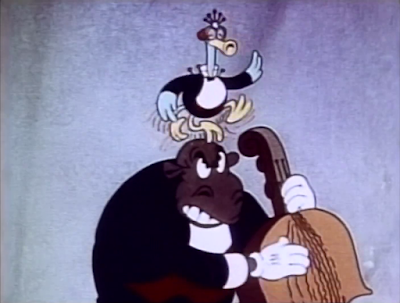And so did the Fleischers.
In A Car-Tune Portrait (1937), a portentous lion conductor poo-poohs the idea of “foolery and clowning,” and suggests this short will be full of “dignity and art.” Well, it starts out that way, as we see members of the orchestra in silhouette, and the conductor in shadow, seriously following King Ross’ arrangement of the classical standard (although a dachshund is supposed to be playing a xylophone but the soundtrack has a string instrument).
Of course, it’s a Fleischer cartoon so things fall apart with the entire orchestra attacking each other and the conductor tearing his hair (fur?) out at the finish.
About half-way into the cartoon, an annoying, odd-looking bird shows up. A tuba player tries to cover him, but he keeps popping out of little doors that open from nowhere.


He gets kicked into the air. Musicians throw instruments at him. Finally, he gets violently batted around with a violin and his head becomes stuck inside a bass.




Now an old cartoon rule is brought into play: any character filled with air starts floating up. In this case, the bird turns into bagpipes before being punctured by a bee and dropping onto the head of a bass player. He does a crazy-legged dance, turning in circles on the gorilla’s head.




Another musician bashes the goofy bird with his instrument, then all the orchestra members jump on top of each other for a destructive finish to the cartoon.

Nick Tafuri is the credited animator for the actual director, Dave Tendlar. The uncredited lion conductor is, to my ear, Alois Havrilla, who voiced travelogues for Van Beuren during the mid-‘30s in addition to various radio announcing jobs. Unlike Liszt’s rhapsody, Havrilla only appeared in this one cartoon to my knowledge.

No comments:
Post a Comment